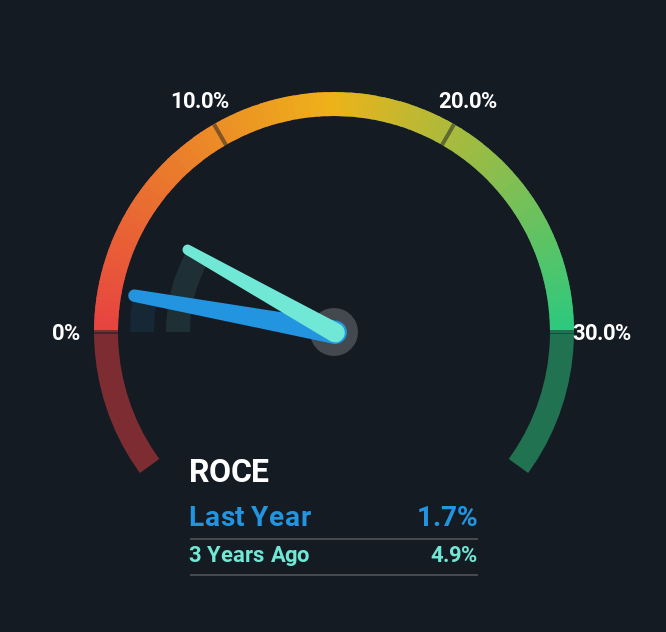- Japan
- /
- Metals and Mining
- /
- TSE:5711
The Returns On Capital At Mitsubishi Materials (TSE:5711) Don't Inspire Confidence
When we're researching a company, it's sometimes hard to find the warning signs, but there are some financial metrics that can help spot trouble early. Typically, we'll see the trend of both return on capital employed (ROCE) declining and this usually coincides with a decreasing amount of capital employed. This indicates the company is producing less profit from its investments and its total assets are decreasing. And from a first read, things don't look too good at Mitsubishi Materials (TSE:5711), so let's see why.
Understanding Return On Capital Employed (ROCE)
For those who don't know, ROCE is a measure of a company's yearly pre-tax profit (its return), relative to the capital employed in the business. To calculate this metric for Mitsubishi Materials, this is the formula:
Return on Capital Employed = Earnings Before Interest and Tax (EBIT) ÷ (Total Assets - Current Liabilities)
0.017 = JP¥18b ÷ (JP¥2.5t - JP¥1.5t) (Based on the trailing twelve months to September 2025).
Thus, Mitsubishi Materials has an ROCE of 1.7%. Ultimately, that's a low return and it under-performs the Metals and Mining industry average of 6.3%.
View our latest analysis for Mitsubishi Materials

In the above chart we have measured Mitsubishi Materials' prior ROCE against its prior performance, but the future is arguably more important. If you'd like, you can check out the forecasts from the analysts covering Mitsubishi Materials for free.
What The Trend Of ROCE Can Tell Us
There is reason to be cautious about Mitsubishi Materials, given the returns are trending downwards. Unfortunately the returns on capital have diminished from the 2.5% that they were earning five years ago. Meanwhile, capital employed in the business has stayed roughly the flat over the period. Companies that exhibit these attributes tend to not be shrinking, but they can be mature and facing pressure on their margins from competition. If these trends continue, we wouldn't expect Mitsubishi Materials to turn into a multi-bagger.
While on the subject, we noticed that the ratio of current liabilities to total assets has risen to 59%, which has impacted the ROCE. If current liabilities hadn't increased as much as they did, the ROCE could actually be even lower. What this means is that in reality, a rather large portion of the business is being funded by the likes of the company's suppliers or short-term creditors, which can bring some risks of its own.
What We Can Learn From Mitsubishi Materials' ROCE
In summary, it's unfortunate that Mitsubishi Materials is generating lower returns from the same amount of capital. But investors must be expecting an improvement of sorts because over the last five yearsthe stock has delivered a respectable 82% return. In any case, the current underlying trends don't bode well for long term performance so unless they reverse, we'd start looking elsewhere.
One more thing to note, we've identified 4 warning signs with Mitsubishi Materials and understanding them should be part of your investment process.
For those who like to invest in solid companies, check out this free list of companies with solid balance sheets and high returns on equity.
New: Manage All Your Stock Portfolios in One Place
We've created the ultimate portfolio companion for stock investors, and it's free.
• Connect an unlimited number of Portfolios and see your total in one currency
• Be alerted to new Warning Signs or Risks via email or mobile
• Track the Fair Value of your stocks
Have feedback on this article? Concerned about the content? Get in touch with us directly. Alternatively, email editorial-team (at) simplywallst.com.
This article by Simply Wall St is general in nature. We provide commentary based on historical data and analyst forecasts only using an unbiased methodology and our articles are not intended to be financial advice. It does not constitute a recommendation to buy or sell any stock, and does not take account of your objectives, or your financial situation. We aim to bring you long-term focused analysis driven by fundamental data. Note that our analysis may not factor in the latest price-sensitive company announcements or qualitative material. Simply Wall St has no position in any stocks mentioned.
About TSE:5711
Mitsubishi Materials
Engages in the manufacture and sale of processed copper products and electronic materials, cemented carbide products, and businesses related to renewable energy in Japan.
Excellent balance sheet average dividend payer.
Similar Companies
Market Insights
Community Narratives




